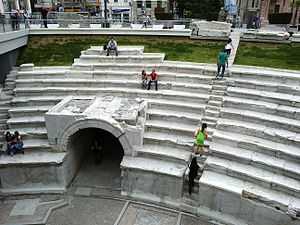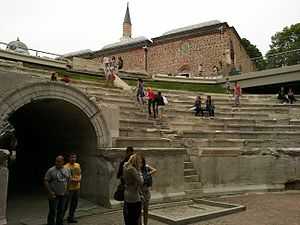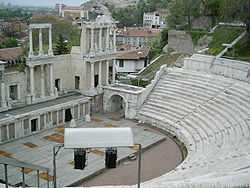Plovdiv Roman Stadium
Coordinates: 42°08′51″N 24°44′53″E / 42.1475679°N 24.7480184°E

The Stadium of Philippopolis in Plovdiv, Bulgaria, is among the largest structures from the time of the Ancient Rome in the Balkan peninsula. Philippopolis and Trimontium (the three hills) were the popular names of the ancient city Plovdiv, Bulgaria during the Ancient Rome.
The Stadium of Philippopolis was built in the beginning of 2nd century AD during the reign Emperor Hadrian (117-138). It is situated in the Northern part of the fortified city surrounded by defensive walls, in the natural terrain between Taksim Tepe and Sahat Tepe. The facility, approximately 240 m (790 ft) m long and 50 m wide, could seat up to 30 000 spectators. The length of the track is one stadion - 600 steps, or approx 180 m (590 ft) m.

The spectators seats are tiered in 14 rows, crossed by stepped aisles down to the track. The seats are made of solid marble blocks (40 cm high and 75 cm wide) and the front parts are decorated with stylized lion paws. The front part of the lowest row is revetted with massive marble 1.80 meters plates (orthostats), stepping on solid marble blocks. The seats from the highest row had backrests.
At Dzhumaya Square in Plovdiv is exhibited in situ the northern curved part of the Stadium (sfendona). Under the tiered rows of seats (cavea), a covered vaulted passage was found. It connected the track with a corridor dug in the terrain. The vault supported the royal seats above it. North of the corridor a section of the fortress wall built back in 2nd century AD was found. It had undergone certain readjustments in 3rd and 4th century AD. In the 4th century AD this area was crossed by an ancient aqueduct.
Like the other imperial buildings for spectacular events, the Ancient Stadium of Philippopolis had its seats of honour preserved by inscriptions in the marble blocks. Seats with Greek inscriptions were found, proving the existence of special seats for members of higher public position.
The main entrance to the Stadium is formed by masonry pillars decorated with marble pilasters and reliefs. On the pilasters there are busts of Hermes (hermai) with placed above them prize vases with palm sprays, accompanied by Hercules’ attributes – lion skin, a mace and a quiver.
The limiting walls of the cavea are built from cut granite stones, labelled with letters at some places. The architectural marble elements of the entrance and the orthostats on the front row were tied to each other with lead-soldered iron cramps. In front of the entrance a granite pavement was uncovered, consisting of hexagonal blocks – 0.70 by 0.70 m diagonally.
According to the epigraphic and numismatic monuments games similar to the Pythian Games in Greece were held in the town. To honour the visit of the Roman emperor Caracalla in 214 the games were called Alexandrian while the games for the visit of emperor Elagabalus in 218 were called Kedrisian Games.
The games were organised by the General Assembly of the province of Thrace. In their honour the royal mint of Philippopolis coined money featuring the face of the ruling emperor as well as the types of athletic events held in the Ancient Stadium. A marble slab stone was found during the excavations of the sfendona proving that there were games celebrating the favourite man of emperor Hadrian – Antinous. The votive tablet dedicated to Antinous is exhibited in the Regional Archaeological Museum - Plovdiv.
Athletes competed in two categories of age – men and boys. Agonothetes (organisers of the sport events) presided over the games. The latter started with a contest for criers and buglers. Sporting events were usually accompanied by music, poetry and art contests.
Today, the stadium is located in the centre of the city, under the main trade street. Only the northern end of the edifice can be observed at Dzhumayata Square. The larger portion still lies beneath the buildings along the main street, running south from the visible part. Further excavation would be very difficult and costly.
The stadium is one of the many preserved buildings from the time of the Roman empire in Plovdiv. Other buildings of the ancient city of Philippopolis are the best preserved Ancient Theatre on the Balkans; fragments of the Forum / Agora, an Odeon / Bouleuterion, fragments of two aqueducts, fortification walls, thermae, a large and a small basilica, a synagogue, residential buildings with some magnificent frescoes and many fragments of streets and buildings.
- Gallery
-
The Ancient Stadium and Dzhumaya square - view from above
-

Part of the sfendona of the Ancient Stadium
-
The vaulted passage-street under the sfendona of the stadium
-

Dzhumaya square - view from North towards the fortification wall and the main pedestrian street of Plovdiv
-
The Ancient Stadium - pillars of the aqueduct and the fortification wall
-
The Ancient Stadium - detail of a signed seat at the sfendona
-
The Ancient Stadium - detail of a seat decorated with a lion paw
See also
- The list of Circus (building), where the stadium of Philippopolis is referred to as Trimontium Roman circus. The relatively small size of the structure, which predicts its usage mainly for athletic games, however, suggests that it is more correct to consider it a stadium, than a circus.
References
| Wikimedia Commons has media related to Ancient stadium, Plovdiv. |
- The Ancient Stadium of Philippopolis (official website) - a detailed information and map of ancient sites in Plovdiv, Bulgaria
- The Ancient Stadium of Philippopolis - 3D reconstruction and virtual tour
- Regional Archaeological Museum Plovdiv - Roman Art, Ancient Sculptures Collection
| ||||||||||||||||||||||||||||||||





